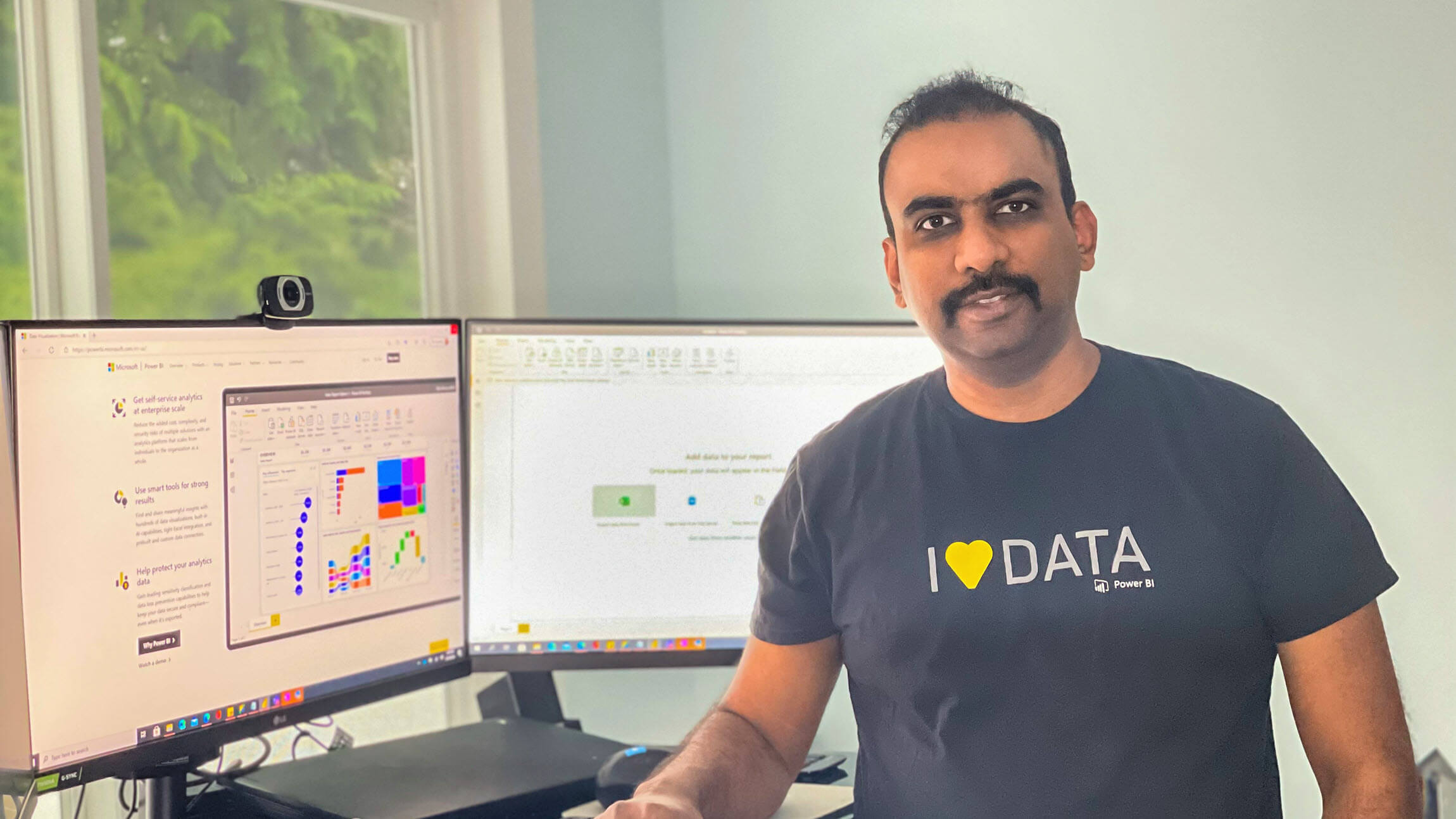 Microsoft’s drive to make more and better data-driven decisions is fueled by analyzing data with Microsoft Power BI.
Microsoft’s drive to make more and better data-driven decisions is fueled by analyzing data with Microsoft Power BI.
But how is it getting employees to analyze their data and build their own visualizations?
They’re teaching them. As the saying goes: if you teach someone to fish, you’ll feed them for a lifetime.
That’s exactly what the Enterprise 360 Data Intelligence team in Microsoft Digital had in mind when it created trainings to help teams that are analyzing data with Microsoft Power BI.
“We wanted to empower our partner teams with the skills, tools, and resources to generate and maintain their own Microsoft Power BI reports and gain access to data in a timely manner,” says Sunil Venugopal, a senior program manager on the Data Intelligence team that helped develop the Microsoft Power BI training. “This also aligns with the expectations of Enterprise 360 Data Intelligence leadership, who wanted to empower partner teams to make data-driven decisions. Once you put data into Microsoft Power BI, it tells a story for itself.”
Using Microsoft Power BI’s easily adaptable features, business users can quickly self-serve the datasets they need and build their own reports … They feel in complete control because they own and invest in it.
– Srinivas Kanamarlapudi, senior software engineer on the Data Intelligence team at Microsoft
This training was a powerful tool, especially for partner teams who wanted to gain data-driven insights that relied on the Data Intelligence team’s data visualizations and reports.
Take Tim Karel, a senior program manager who uses data visualizations to respond to system-generated issues or process changes. Karel submitted many of the dozens of requests from partner teams that were fielded by the Data Intelligence team. The Data Intelligence team would evaluate each request for feasibility, identify core metrics, find a data source, and build a data ingestion pipeline and visualization.
As a result, employees on partner teams, like Karel, could wait several weeks before receiving a data visualization or report.
“By the time I received a report, the business needs or data might have changed,” Karel says. “Our team wanted to be more proactive and use data to create a better customer experience up front.”
Now, thanks to the training developed by the Data Intelligence team, Karel is analyzing data with Microsoft Power BI. During the training, Karel and other employees on partner teams learned the basics of Microsoft Power BI and used the data team’s standard template to create their own visualizations.
“Using Microsoft Power BI’s easily adaptable features, business users can quickly self-serve the datasets they need and build their own reports,” says Srinivas Kanamarlapudi, a senior software engineer on the Data Intelligence team who was involved in creating the Microsoft Power BI training for partner teams. “This also improves their skillset, and they feel in complete control because they own and invest in it,” Kanamarlapudi says.
The initial training session drew in 80 participants, including Microsoft network engineers, software engineers, program managers, and even members of leadership who had beginner skills using Microsoft Power BI.
“Through these trainings, employees learn the best practices for analyzing data and building out reports, which creates consistency across how these reports are built and enables other teams to easily grasp the visualizations in the reports,” Kanamarlapudi says.
In addition to offering data science trainings, the Data Intelligence team encourages the employees they work with to build Microsoft Power BI reports that source data from the Microsoft Digital’s central Enterprise Data Lake, which offers a single source of trusted, connected enterprise data.
“By leveraging the shared infrastructure, we’re able to prevent duplication across multiple teams,” Venugopal says.
For employees like Karel, the training is already paying off. Data continues to be a core part of decision-making on their team and using data visualizations to track trends has become a central part of that.
“There were many philosophies about what constitutes a good customer experience, so we need data to drive impact and changes,” Karel says. “Data tells us how customers interact with agents or get support, and we’re able to make the best decisions possible for customers.”
By analyzing data with Microsoft Power BI, Karel has been able to create visualizations that identify customers who make repeat support calls and track agent utilization across product areas to see if the team needs to have more support agents during busier times of day.
“I had a fundamental understanding of my team’s data, but the training taught me how to use a reliable data source to build data reports using Microsoft Power BI, and automate it,” Karel says. “It saves me a lot of time, and it enables us to improve the customer experience.”
It’s also making a difference for the Data Intelligence team, who now have more bandwidth to support partner teams by answering questions and helping them get the most out of their data.

Colin Tang, a software engineer on the Data Intelligence team who primarily creates datasets, data reports, and dashboards for network infrastructure teams, says that it’s exciting to see teams taking the training and running with it. Tang recently worked with a partner team that manages the inventory for network parts.
“Our partner took the dataset and went ahead to build the dashboard for network device vendors, and it helps him drive conversations with vendors about cost savings,” Tang says. “It would normally take our team two to three sprints, but he built his own and they can have conversations with vendors in half the time.”
[Check out how Microsoft designed a modern data catalog to enable business insights. Learn how Microsoft enhanced its VPN performance.]
Building visualizations using Microsoft Power BI
Training has always been around, so what was different this time?
The team brought a relevant, easy-to-follow Microsoft Power BI training directly to partner teams, each with their own data needs. This made it much easier for teams analyzing data with Microsoft Power BI to scrub their data and then build appropriate visualizations.
“A lot of trainings are complicated and don’t focus on real-world scenarios that show up in the work of partner teams like mine,” Karel says. “This is one of the best trainings I’ve taken at Microsoft, and I appreciate that it’s accessible to everyone without relying on a background in engineering and software development.”

To build a community, the Data Intelligence team continues to offer office hours, where employees could ask questions or refine their visualizations. The Data Intelligence team also created a Microsoft Teams channel where employees could ask questions and share their experiences and resources. They’ve also found more success with offering trainings on the organization’s meeting-free Fridays, which are specific days set aside for employees to catch up on email or dedicate time to learning.
“We build on existing trainings and content about how to analyze data with Microsoft Power BI, which ensured that we didn’t reinvent the wheel,” Venugopal says. “Even if someone has attended trainings in the past and built dashboards, they can still learn something.”
To get the most engagement and support on a training like this one, Tang says it was helpful to take a top-down approach and get leadership buy-in from the very beginning. At the time, Tang had been conducting dozens of one-on-one sessions with partners to go over their data needs and wanted to offer something at scale.
“We went back to our leadership team and asked if we could offer Microsoft Power BI training that could reach more people at once and help them take advantage of all of its features,” Tang says.
There were many philosophies about what constitutes a good customer experience, so we need data to drive impact and changes. Data tells us how customers interact with agents or get support, and we’re able to make the best decisions possible for customers
– Tim Karel, senior program manager at Microsoft
It also helped that the team had leadership buy-in and resources to create this training which has ensured that teams have consistency in the way they construct reports and dashboards. This has improved the user experience for partner teams and the Data Intelligence team alike, and they can focus on supporting partner teams and democratizing data instead of building reports.
If you’re on the fence about building your own data visualizations using Microsoft Power BI, or creating a team-wide training, here’s Karel’s advice:
“Embrace Microsoft Power BI and other tools for building your own visualizations. And if you’re creating a data training, start by teaching the basic components and build on that.”


